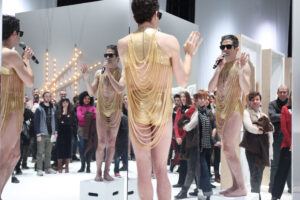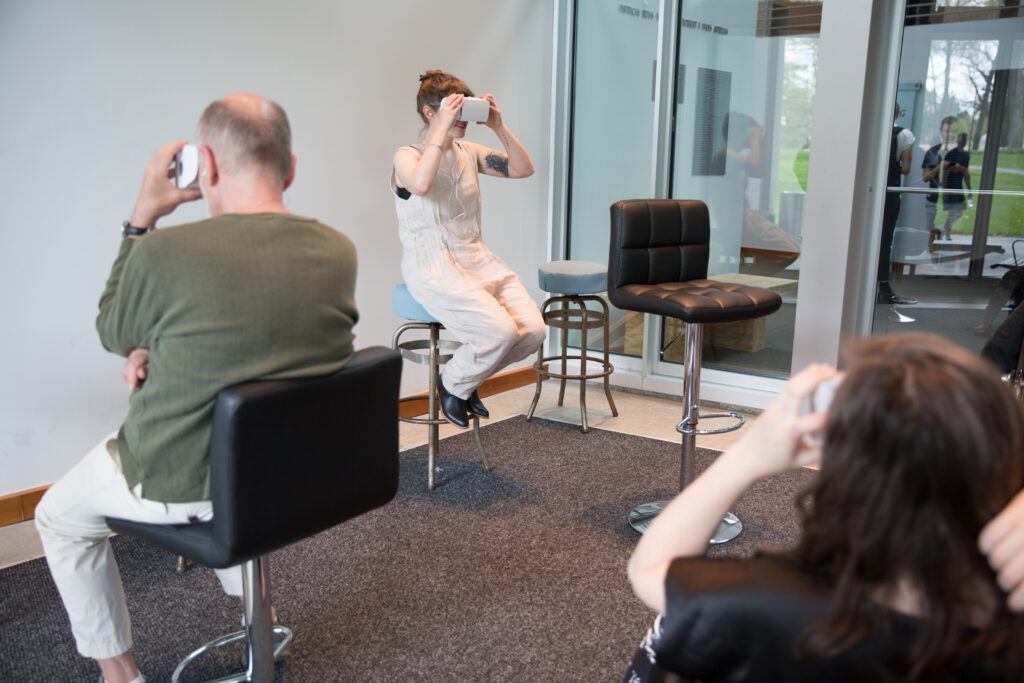The technologies of surveillance have redefined the nature of contemporary human life and society.
In our interactions with government, law enforcement, corporations, and one another, we live in a constant state of watching and being watched—with varying degrees of visibility and consciousness.
The second Fisher Center LAB Biennial explores the vast implications of life in a state of surveillance, and the impact of that reality on security, democracy, ethics, creativity, and citizenship.
Credits
Co-Curators Gideon Lester and Caleb Hammons
Festival Artists
Big Art Group
Annie Dorsen
Hasan Elahi
Michelle Ellsworth
Claudia Rankine, Will Rawls, and John Lucas
Samuel Miller ’15
Alexandro Segade
Discursive Programs and Resource Room Anna Gallagher-Ross CCS ’17 and Miriam Felton-Dansky
Social Media Coordinator Kirsten Harvey ’17
Blog Coordinator Rebecca Capper ’17
Festival Photographer Julieta Cervantes
Read the Full ProgramCurators’ Note
The 2017 Live Arts Bard Biennial, We’re Watching, is a performance exhibition about surveillance. The exponential growth of the surveillance state—and its effect on human rights and on our political, social, and private lives—has become one of the defining subjects of the twenty-first century. Surveillance technology and its controversial uses is ever present in the news and may have irreversibly altered our lives—from state- sponsored hacking, WikiLeaks, corporate espionage, police body cameras, and drone warfare to the purportedly benign technologies of street mapping, social media, and the so-called Internet of Things.
We’re Watching brings together seven reflections on surveillance by contemporary American artists through the analog (and perhaps archaic) technologies of live performance. All of these projects are new, some are works-in-progress, and most were commissioned by Live Arts Bard. The relationship between subject and form might seem paradoxical: surveillance is anonymous, mechanized, and impersonal, the data it collects can be archived indefinitely, disseminated, and searched. Performance, by contrast, is intrinsically ephemeral and dependent on human interaction. Its liveness cannot be wholly recorded, transmitted, or reproduced. Yet performance and surveillance, in the broadest sense, have a long and intricate relationship. Theater, dance, and other live arts are built on a relationship between spectator and performer; the very word “theater” is derived from the Greek for “the watching place.” In its expansion and reach, the contemporary surveillance state has developed nearly infinite platforms for performance and voyeurism, from Twitter feeds to the wearable cameras that will, by some estimates, be owned by 80% of the world’s population in 2020.
This uneasy symbiosis between surveillance and performance, machine and human, is a recurring theme in many of the projects of We’re Watching. Although the exhibition’s subject is politically charged, these biennial artists have approached it obliquely, choosing metaphor and fantasy over direct representation. They have conceived seven non-literal spaces to encourage reflection, imagination, investigation, and resistance, from the vertiginous, inverted pastoral of Retina to the realm of the “already dead” of What Remains, the disorienting planetarium of The Great Outdoors, the dystopias of Opacity and Future St., and the laboratories of The Rehearsal Artist and Foundation for Healing. Collectively they challenge us to consider incursions of surveillance into our lives, and also to consider what in us might remain private, hidden from view— unsurveillable.
We’re Watching is the culmination of the second edition of the Live Arts Bard Biennial, a two-year program comprising artist residencies and commissions, academic conferences, and related undergraduate courses at Bard College. On behalf of all our colleagues we are thrilled that you have joined us. We hope to welcome you back often to the Richard B. Fisher Center for the Performing Arts.
— Gideon Lester, Artistic Director of Theater and Dance and Caleb Hammons, Senior Producer
Works
BIG ART GROUP
OPACITY

Opacity is built around the framework of the “interface,” specifically the threat of increasingly opaque intermediation between the digital and the physical. Through a series of scenes of mundane life staged in sculptural abstraction alternating with synthetic songs, the performance uses computational models to hack, encrypt, spoof, troll, spam and camouflage our digital identities, and return the coded selves back into the realms of the real.
ANNIE DORSEN
THE GREAT OUTDOORS
In the darkness of a planetarium a performer guides us on a journey through inner space, stitching together the thoughts of countless individuals using text culled from internet comments. We think of comments as the Internet’s id—unrestrained, anonymous, let loose. Is this id a roiling sea of primal drives, or a thoroughly structured and colonized territory?
MICHELLE ELLSWORTH
THE REHEARSAL ARTIST
A rehearsal studio-turned-laboratory where a small group of audience members peep through a one-way mirror at a performer responding to choreographic instructions, derived from the canon of social science experiments. Each “rehearsal” is recorded and iteratively incorporated into the following performances. As the audience’s perception shifts and extends, the performance amplifies and destabilizes the act of watching.
CLAUDIA RANKINE, WILL RAWLS, AND JOHN LUCAS
WHAT REMAINS
What Remains stages encounters for a culture that cannot memorialize without exposing society’s role in the disturbance and murder of its citizens. Through movement, language, and video it invites us across the threshold of this historical void, creating an immersive environment from the idea of an entombed imagination, and responding to violence and disappearance with a resonant, ghostly chorus.
ALEXANDRO SEGADE
Future ST.
A sci-fi saga set in a dystopian Southern California city, where a homosexual police state enforces strict marriage codes among the monitored populace, and an intersectional resistance, made up of queer mutant dissidents and an ancient feminist underground, plots its overthrow. Future St. is a speculative, multi-media theater epic exploring desire, surveillance and the sinister forces of normalization.
SAMUEL MILLER ’15
Foundation for Healing
Foundation for Healing is a new form of Virtual Reality therapy that focuses on exorcising trauma and hypervigilence caused by living under mass surveillance. A patient will demonstrate to you the intimate methods of mental and spiritual rejuvenation they use to thrive in a hostile digital landscape.
HASAN ELAHI
RETINA

In his new series, Retina, Hasan Elahi uses Google Street View imagery to interrogate and disorientate our relationship with natural and built environments. In this site-specific commission, Elahi employs surveillance imagery to render the walls of the Fisher Center apparently invisible, giving spectators an uncanny view of the parkland beyond. The images are printed upside down and inverted in the space, as if generated by a camera obscura. Retina makes reference to the camera as a tool of surveillance and also acknowledges that the camera obscura was one of the oldest types of surveillance technology. The use of Google Street View addresses the state’s increasing reliance on public-private partnerships, and the exploitation of “public” data, for purposes of surveillance.
Theater Journal
Spectatorship in an Age of Surveillance
An issue of Theater • Volume 48, Issue 1 • Published February 2018
 Contributors to this special issue investigate the ways surveillance and the fields of theater and performance inform one another. Considering forms of surveillance from government mass spying to data mining to all-seeing social networks, the contributors demonstrate how surveillance has found its way into our lives, both online and off, and how theater and performance—art forms predicated on heightened experiences of viewing—might help us recognize it. This issue includes scripts, photographs, essays, interviews, and reviews from Live Arts Bard’s 2017 performance biennial We’re Watching, a series of commissioned performances paired with a conference of scholars and artists. The performances focus on the appropriation and integration of surveillance technologies into theater and performance, such as a piece that uses Python code and Twitter data to create performance text, and one that uses an interplay of video projection, movement, and poetry. Drawing on these performances and more, contributors collectively argue that contemporary surveillance is characterized by both anonymous systems of digital control and human behaviors enacted by individuals.
Contributors to this special issue investigate the ways surveillance and the fields of theater and performance inform one another. Considering forms of surveillance from government mass spying to data mining to all-seeing social networks, the contributors demonstrate how surveillance has found its way into our lives, both online and off, and how theater and performance—art forms predicated on heightened experiences of viewing—might help us recognize it. This issue includes scripts, photographs, essays, interviews, and reviews from Live Arts Bard’s 2017 performance biennial We’re Watching, a series of commissioned performances paired with a conference of scholars and artists. The performances focus on the appropriation and integration of surveillance technologies into theater and performance, such as a piece that uses Python code and Twitter data to create performance text, and one that uses an interplay of video projection, movement, and poetry. Drawing on these performances and more, contributors collectively argue that contemporary surveillance is characterized by both anonymous systems of digital control and human behaviors enacted by individuals.
Special Issue Editors Miriam Felton-Dansky, Tom Sellar, and Jacob Gallagher-Ross
Contributors David Bruin, Annie Dorsen, Shonni Enelow, Miriam Felton-Dansky, Jacob Gallagher-Ross, Caden Manson, John H. Muse, Jemma Nelson, Jennifer Parker-Starbuck, Alexandro Segade, and Tom Sellar
Festival Blog
Learn more about the artists and projects in We’re Watching, via the festival blog by curatorial fellow Anna Gallagher-Ross CCS ’17.
Explore the Blog
Syllabus
 Bringing together diverse perspectives on surveillance that span literature, music, film, critical theory, and beyond selected by the artists featured in We’re Watching.
Bringing together diverse perspectives on surveillance that span literature, music, film, critical theory, and beyond selected by the artists featured in We’re Watching.
















